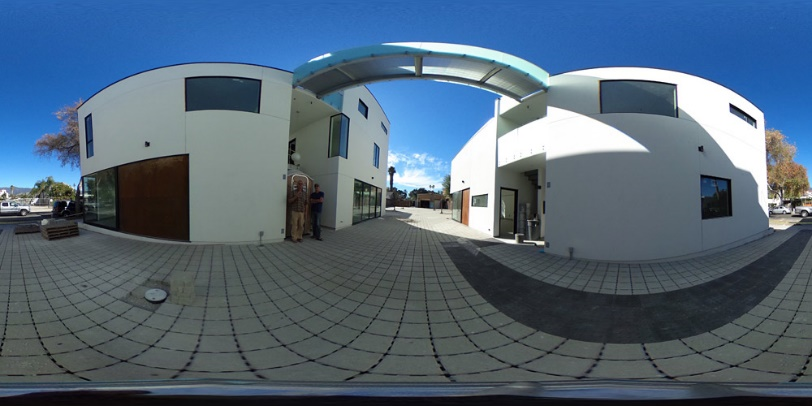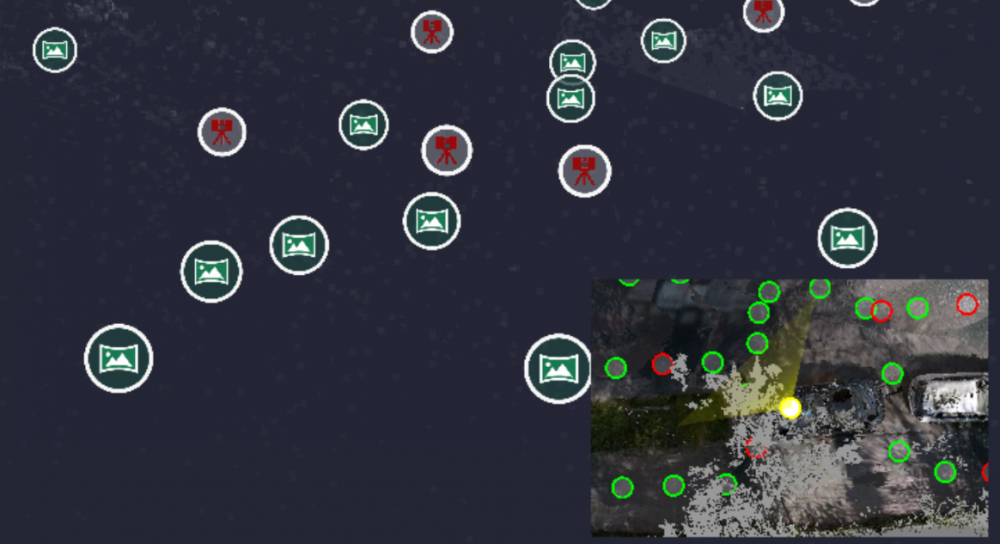You can import 360° images in Cintoo Cloud provided that those 360° images have been geolocated and are in the same coordinate system that the 3d scans.
Beta feature
This is a beta feature starting Dec 14th, 2020. Being a beta feature:
- The access to it is valid for all Cintoo Cloud subscribers.
- The 360° images do not count as scans in your scan count.
- The maximum number of 360 images that you can upload to Cintoo Cloud is limited to the number of scans that you subscribed to.
- For example, if you have a subscription for 5,000 scans, you can upload up to 5,000 additional 360° images.
- 360° images are 2D only, so you cannot use them to add annotations (which are linked to a 3D point) or to make measurements. They are used for display only.
Step 1 – Prepare your 360° Images
Your 360° images must be stored in a single folder together with a CSV file containing the information about the location and orientation of each panorama. The expected formats are the following:
- All the 360° images will need to be spherical images in JPEG or PNG. Example spherical image:

- The same folder will need to include a CSV file that contains 360° image name (with extension), location and orientation, for each 360° image.
- The CSV file will need to be as follows:
- Use comma (,) as column separator
- The column for the file name must be named filename
- Filenames should have their extension (.jpg or .png)
- For the position, name the columns as x, y and z
- x, y and z values must be in meters, in the same coordinate system as your scans.
- The orientation needs to be given as a quaternion oras a simple heading
- Important: Since both quaternion notation and heading are supported as orientation, you cannot have heading and quaternion in the same csv. It is either one or the other, otherwise Cintoo Connect will reject it.
- If you are using quaternions for the orientation:
- Name the columns as qx, qy, qz, qw
- That way, your first column should look like (the order doesn’t matter): filename, x, y, z, qx, qy, qz, qw
- It would be qw = 1 and qx = qy = qz = 0 for “no rotation” with quaternions.

- If you are using a heading value for the orientation:
- Create a column named ‘heading’ in the csv file.
- The heading parameter represents an angle in degrees, a rotation around the Z axis. From the top view, a positive angle represents a rotation in the clockwise direction (towards east).
- Important: when using heading there will be no rotation applied around the X or Y axes. We assume that the 360 images are well aligned vertically (the plane crossing the “equator” line of the must be parallel to the XY plane), otherwise the image will look as it is not straight (ex: a straight building would look like it has some slope).
- The angle takes as reference the middle of the image and the north direction:

- Heading set to 0 means that you will see the middle of the image when looking towards north (+Y).
- Heading set to 90 degrees means that you will see the middle of the image when looking towards east (+X).
- Heading set to 180 degrees means that you will see the middle of the image when looking towards south (-Y).
- Heading set to 270 degrees (or -90 degrees) means that you will see the middle of the image when looking towards west (-X).
- Note that the Navigation Map on the bottom right corner can help you to find out to which direction you are looking at:
Step 2 – Upload the 360° Images using Cintoo Connect
You will need to use Cintoo Connect to upload 360° images.
- Install the latest version of Cintoo Connect (check this section: Installing Cintoo Connect)
- This beta program starts with Cintoo Connect version 1.12.
- We advise you to create a specific Work Zone.
- In this Work Zone, click on ‘Prepare & Upload’:

- Or click on ‘Upload 360° Images’ in the top right of the Window:

- This will run Cintoo Connect on your computer:

- The number of 360° images that you can upload is displayed:

- When clicking on ‘Select 360° Images’, you will need to select the CSV file that lists your spherical image:

- The import and upload process will start automatically.
360° Images Display
- Your 360° Images will be displayed in the DATA tab with a dedicated icon:

- In the Overview Map, the 3D View and the Navigation Map, the 360° Images will appear with green icons:

- You can then navigate from a scan to a 360° image, a 360° image to a 360° image or a 360° image to a scan.
- 360° images are 2D only, so you cannot use them to add annotations (that are linked to a 3D point) or to make measurements. They are used for display only.
Was this article helpful?
That’s Great!
Thank you for your feedback
Sorry! We couldn't be helpful
Thank you for your feedback
Feedback sent
We appreciate your effort and will try to fix the article